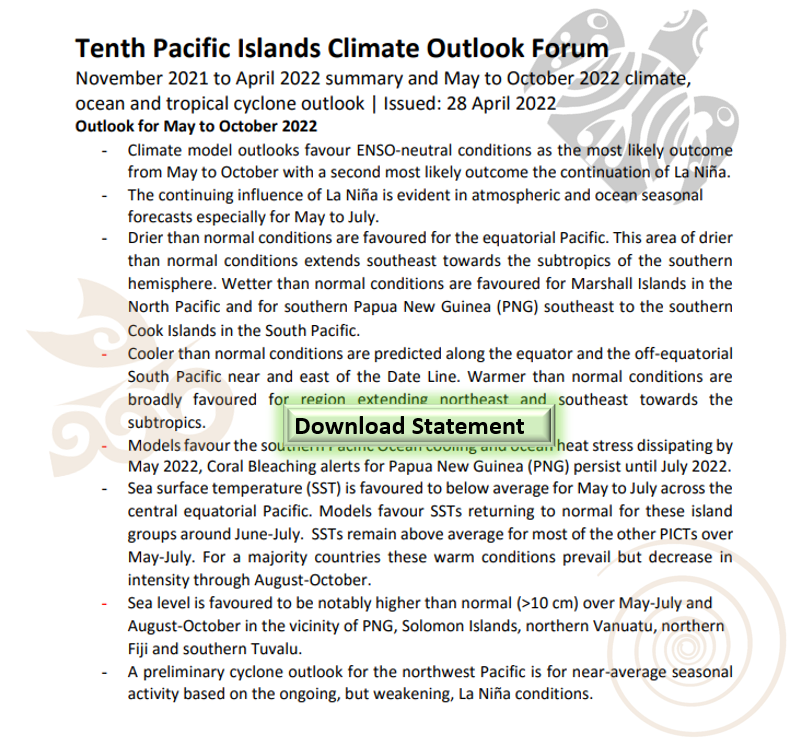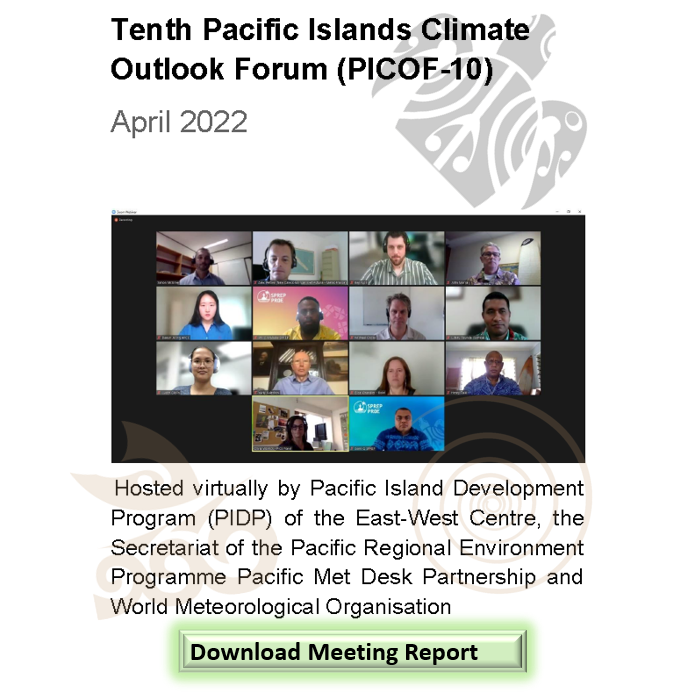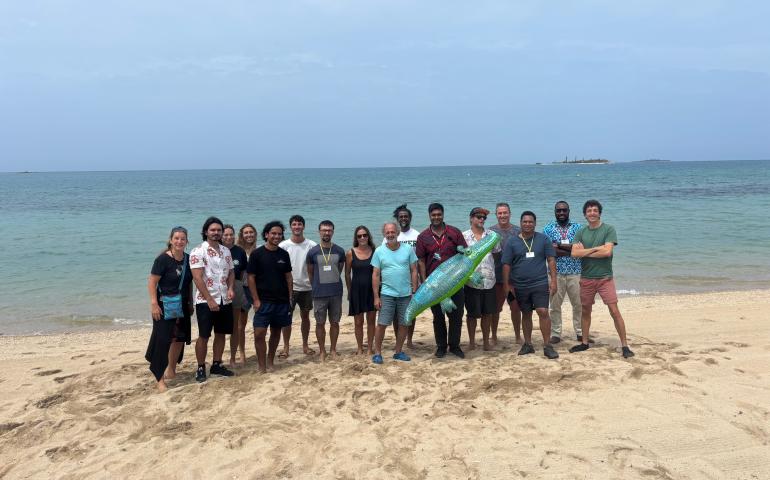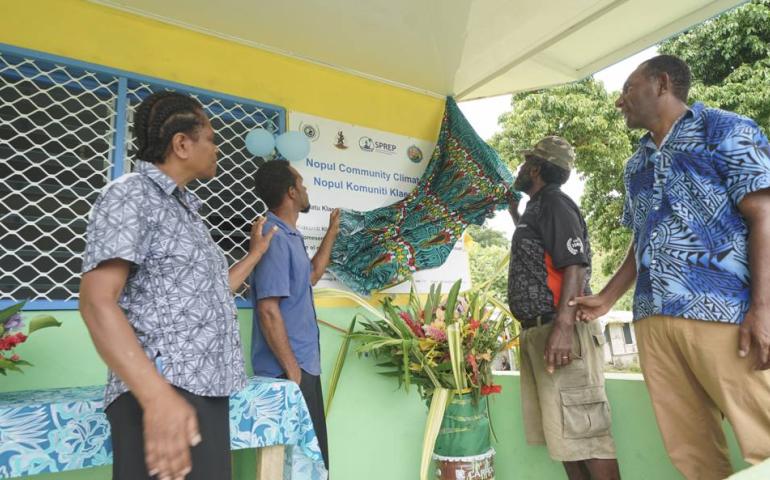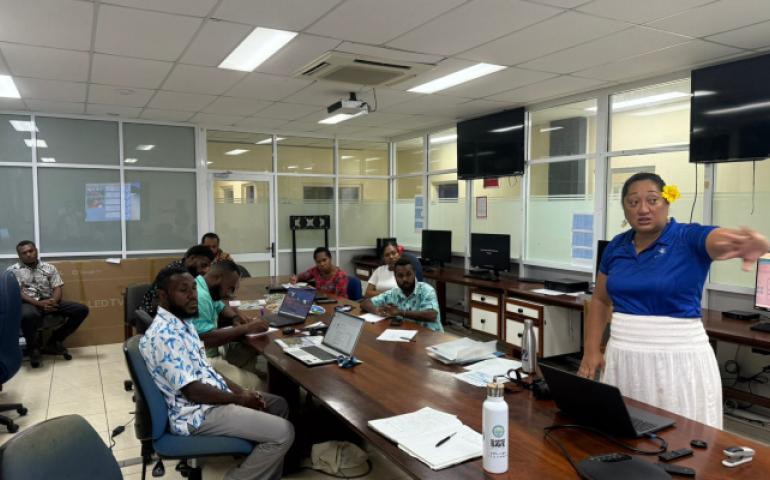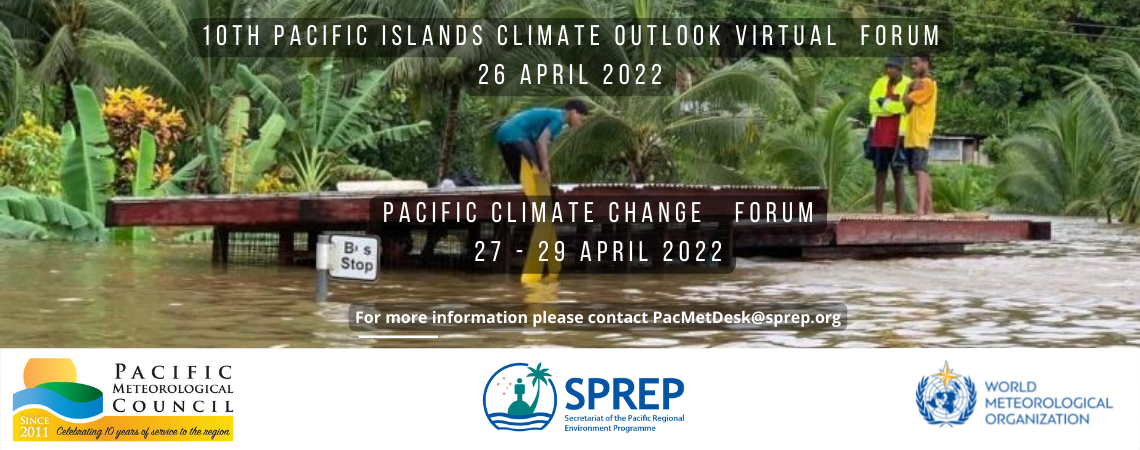
10th session of the Pacific Islands Climate Outlook Forum (PICOF-10)
Virtual Meeting 26 April 2022 23:30- 03:30 UTC
(12:30-16:30 WST/ April 25 13:30-17:30 HST)
*Zoom Webinar Format*
The Pacific Islands Climate Outlook Forum (PICOF) is based on the World Meteorological Organization (WMO) https://public.wmo.int/en/our-mandate/climate/regional-climate-outlook-products Regional Climate Outlook Forum (RCOF) concept.
The PICOF is co-organized by the Secretariat of the Pacific Regional Environment Programme (SPREP) and the World Meteorological Organization (WMO), with technical support provided by the Australian Bureau of Meteorology (BOM), National Institute of Water and Atmospheric Research (NIWA), APEC Climate Centre (APCC), Meteo-France, US National Oceanic and Atmospheric Administration (NOAA), Pacific Community (SPC) and the University of Hawaii) as members of the Pacific Regional Climate Network (RCC) Node for Long-Range Forecasting in partnership with the Pacific Islands Climate Services (PICS) Panel. The latter ensures the needs of National Meteorological and Hydrological Services (NMHSs), and their stakeholders are met. The PICOF sessions are co-sponsored by the WMO through CREWS Pacific SIDS Project, funded by the CREWS Initiative and Environment and Climate Change Canada (ECCC). BOM, SPREP and SPC support is largely provided via the Australian and New Zealand Aid funded Climate and Oceans Support Program in the Pacific, and Republic of Korea-Pacific Islands CliPS project.
Additional information on PICOF and the WMO Pacific RCC Network is available via https://www.pacificmet.net/rcc.
The focus of the first PICOF of the year (late April) is to review climate and oceans conditions in the last 6 months and climate and ocean seasonal and sub-seasonal forecasts for the next 6 months. Participants include participants from NMHSs and Pacific RCC Network members. The second PICOF of the year (late October) is an extended event tailored to a priority sector. In 2022, the April PICOF will include a Climate Change component which will include monitoring and projections of key atmospheric and ocean variables. The PICOF will be followed by the official launch of the Pacific Climate Change Monitor 2021 and Pacific Climate Change (PCC) Forum.
Overall objective: To discuss and produce objective, user-relevant regional climate and ocean outlook guidance in real-time to support Pacific Island Countries and Territories (PICTs) NMHSs produce national climate and oceans climate information for their national stakeholders, with the ultimate aim to reduce climate-related risks and support sustainable development for the coming season in sectors of critical socioeconomic significance.
The specific objectives of PICOF include the following:
- Build partnerships among NMHSs and Pacific RCC Network members, to facilitate uptake and use of climate and ocean products and services in support of the PICTs of the region;
- Compare forecast guidance for the PICTs region and discuss how these are produced in terms of accuracy, utility, weaknesses and strengths;
- Present, discuss, and summarise the climate and ocean conditions for the last six months and model outlooks for the next six months in the Pacific Islands region;
- Discuss how NMHSs are currently accessing and assessing the available guidance, making them nationally relevant, tailoring them for specific end users, and disseminating them to users;
- Continue capacity building/human resource development activities for the NMHSs, particularly on sectoral application aspects of seasonal and sub-seasonal predictions;
Expected Outcomes:
- Better understanding of the drivers of variability and state of Pacific Island climate and ocean over the preceding 6-month season;
- Improved understanding of climate, ocean and tropical cyclone outlooks over the coming 6-month season, reasons for differences between model outlooks and model confidence for the outlook period;
- Production of a regional statement summarising the ENSO state, tropical cyclone, climate and ocean patterns from the start of the preceding season and outlooks for these variables to the end of the 6-month outlook period;
Proposed Timeline for PICOF Statement development (dates refer to Samoa local time)
Monday 18 February 2022: Pacific NMSs notified of upcoming virtual PICOF-10.
Thursday 21 April 2022: Node members send content to session coordinators to summarise.
Monday 25 April 2022: Deadline for PowerPoint presentations to be sent to the PICS panel secretariat.
Tuesday 26 April 2022: Virtual PICOF teleconference held (see agenda below).
Wednesday 27 April 2022: Draft version of the PICOF Statement circulated to the node members for content verification. Deadline Thursday 28 April 2022.
Thursday 28 April 2022: Final draft of the PICOF Statement sent to the PMC members, the deadline for responses Friday 29 April 2022.
Monday 2 May 2022: PICOF statement released.
PICOF-10 STATEMENT
PICOF-10 Report
AGENDA & PRESENTATIONS
Agenda
Virtual Meeting 26 April 2022 23:30- 03:30 UTC
(12:30-16:30 WST/ April 25 13:30-17:30 HST)
|
TIME |
AGENDA TOPIC |
|
12:30-13:00 (Samoa local time) {30 min} |
Registration and communications testing Meeting procedures |
|
13:00-13:30
{30 min} |
Agenda 1: Opening and Setting the scene.
|
|
13:30-13:50
{20 min} |
Agenda 2: ENSO Update and Outlook. [Download presentation] ENSO status and outlook, and introduction to ENSO tracker: NIWA, BoM, Meteo-France, NOAA, University of Hawaii, APCC, SPREP and SPC (15 minutes) Including highlights from Global Seasonal Climate Update (GSCU)
|
|
13:50-14:35
{45 min} |
Agenda 3: Looking Back - Review and Evaluation of May-October 2021 Climate outlook.
Overview of May to October 2021 state of the climate, plus evaluation of the last PICOF outlook: NOAA, University of Hawaii, BoM, SPC, SPREP, and NIWA (12 minutes).
Overview of May to October 2021 state of the ocean, plus evaluation of the last PICOF outlook: NOAA, University of Hawaii, BoM, SPC, SPREP, NIWA (12 minutes).
Overview of the TCs over last six months: NOAA, University of Hawaii, BoM, SPC, SPREP, and NIWA (12 minutes). Agenda 3 discussion (9 minutes) |
|
14:35-14:55
{20 min} |
Agenda 4: Looking Back Long-Term: Status of key variables [Download Presentation - Sea Level (NOAA)] [Download Presentation - Tropical Cyclone Trends (BoM)] A brief examination of long-term trends for variables of interest to Pacific communities: In April 2022, these will be tropical cyclones and sea level: NOAA, University of Hawaii, BoM, SPC, SPREP, and NIWA (10 minutes). Agenda 4 discussion (10 minutes) |
|
14:55-15:05 {10 min} |
BREAK |
|
15:05:16:05
{60 min} |
Agenda 5: Looking Forward - Seasonal and Intra-seasonal Pacific guidance for 2021/22.
PICOF outlook and RCC Node for LRF individual model/MME guidance and skill comparison: NIWA, BoM, Meteo-France, NOAA, University of Hawaii, APCC, SPREP, and SPC (15 minutes).
PICOF outlook and RCC Node for LRF individual model/MME guidance and skill comparison: NIWA, BoM, Meteo-France, NOAA, University of Hawaii, APCC, SPREP, and SPC (15 minutes).
PICOF outlook and RCC Node for LRF individual model/MME guidance and skill comparison: NIWA, BoM, Meteo-France, NOAA, University of Hawaii, APCC, SPREP, and SPC (15 minutes) Agenda 5 discussion (15 minutes) |
|
16:05-16:25
{20 min} |
Agenda 6: Looking Forward Long-Term [Download Presentation] A brief review of long-term climate change projections for variables of interest to Pacific communities: In April 2022, these will be tropical cyclones and sea level: CSIRO, UGCRP, BoM and SPREP (10 minutes). Agenda 6 discussion (10 minutes) |
|
16:25-16:30
{5 min} |
Agenda 7: Closing Chair: Summary of proceedings, feedback from participants Next steps: production of PICOF 10 Report, PICOF Statement, a reminder of production deadlines. Proposed dates for PICOF 11: Friday 21 October and Tuesday 25 October 2020. Theme: tbd |
